Exhibit 1 text
1997.03.20
Life and Death within Piranesi's Ichnographia of the Campo Marzio
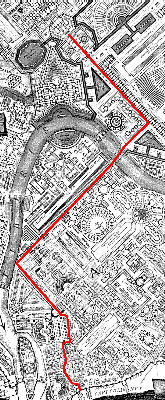
With a consistent dashed line, Piranesi demarcates the Triumphal Way through the Campo Marzio. The processional route begins, with historical and archeological accuracy, at the Templum Jani, which is situated at the bottom of the Ichnographia. The victor's march weaves through Rome's "theater district"--past small baths, shops, and brothels--and then continues on a long straight course towards the Tiber. Across the river, the procession turns behind the Sepulchrum Hadriani and approaches its end at the Templum Martis, the god of War and for whom the Campo Marzio is named. As the ultimate destination of the Triumphal Way, the Templum Martis is clearly among the most sacred, if not the most sacred, of places within the Campo Marzio, and, therefore, perhaps offers a key that lifts the Campo Marzio's "mask."
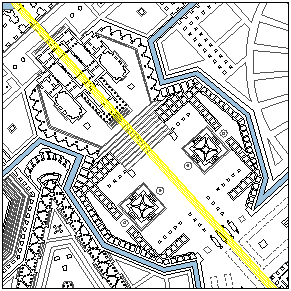
The Templum Martis fittingly promulgates overt manliness. Male genitalia boldly inform the Temple's plan, and the linear projection of the Temple's "endowment" manifests the Campo Marzio's longest straight axis.
As the axis of Mars spans from the Vatican Hill to the bend in the Tiber, it intersects the Campo Marzio's second longest straight axis, which bisects Hadrian's Tomb and the Bustum Hadriani. The perpendicular crossing of the two axes naturally creates a diametrical opposition. Geometry alone, however, does not represent the depth of their oppositeness.
The axis of Mars terminates at either end with a nymphaeum, while the axis through the Bustum Hadriani terminates at either end with an Imperial Tomb. The antithesis of nymphaeums and tombs is self-evident, and, therefore, attests to the axis of Mars representing life and the Bustum axis representing death.
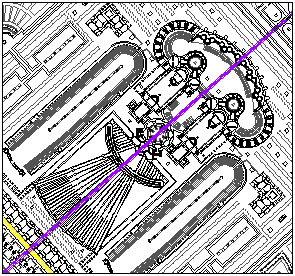
The Bustum Hadriani with its crematoriums and funereal banqueting halls, moreover, is nothing less that a gigantic "machine" to facilitate the passage from this life to the next. Yet, for all its architectural bombast, the Bustum Hadriani can in no way compete with the exalted simplicity of the tiny unnamed structure, which is behind the nymphaeum on the bank of the Tiber and at the very tip of the axis of life.
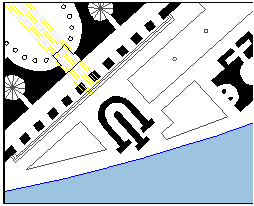
| |
architectural promenade
1997.08.05
...the new ideas re: the architectural promenade that developed because of the Danteum. Essentially, the Danteum has the same sequential series of architectural "events" as the formula for the architectural promenade that I have extracted from Le Corbusier and Stirling. The Danteum, however, adds the element of a journey from the profane to the sacred, and this addition significantly opens up the interpretive field and the buildings that can now be included as exhibiting the architectural promenade formula.
With regard to the profane/scared aspect, the triumphal way within Piranesi's Campo Marzio exhibits the same sequence. The procession (promenade) begins at the Templum Jani, a tetrahedron, which is the forest, the pilotis that raise the box. From there the route jaggedly marches through the "theater district" (downtown)--this is hell, the profane, the lower level. Just as the "way" approaches the Banks of the Tiber for the first time, the procession becomes straight and passes repetitive / monotonous buildings. The way remains perfectly straight except for two 90 degree turns, and this course comprises the greatest length of the promenade. (The straight portion of the procession passes, in sequential order, the Hecatonstylon and the outer niched wall of the Horti prius Pompejani deim Marci Antonii; then the long portico of the Stadium opposite the Domus Alexandri Severi; and across the river between the Porticus Hadriani and the Sepulchrum Libertorum et Servorum of the Bustum Hadriani. These buildings well exemplify the notion of inside/outside, thus tying the triumphal way more closely to the architectural promenade formula.) In the course of this long march, the procession crosses over from the area (of the Campo Marzio) that primarily represents life (inside/outside -- osmosis connection?) into the area that is primarily of death (the Bustum Hadriani). This is the same transition as in the Danteum's Purgatory, and the middle inside/outside level of the Villa Savoye (etc.). Ultimately, the Triumphal way ends at the Templum Martis, easily the most sacred place/space of the Campo Marzio. This culmination to the triumphal procession is analogous to the Paradiso of the Danteum, and to the solarium of the Villa Savoye (etc.). Of course, this has major implications towards my previous analysis of the Triumphal Way.
| |
Mistakes and Inversions
1998.02.19
...address Piranesi's own mistakes and inversions, particularly the inversion of the Circus Flaminius (which I now know to be also exchanged in location with the theater of Balba, which further shows Piranesi's intentional "mistakes" to make a specific point). [Perhaps,] Piranesi makes the mistakes, first to call attention to specific points, and second to highlight the notion of inversion. Piranesi is indeed being theatrical, which is only natural because of the whole notion of reenactment. ...discuss the Ichnographia's Triumphal Way and how Piranesi redesigns (reenacts) the Way making it more ideal to its purpose (marching through the theater district). The Way (within Ichnographia at least) ends at the Temple of Janus--a perfect example of inversion. Then following the Triumphal Way in reverse manifests the Christian theme of salvation and redemption, ending at the inverted "basilica"--the upside-down "inverted" crucifixion of St. Peter. ...the Ichnographia not only represents the history of ancient pagan city of Rome, but also the Christian city of Rome. This evokes Augustine's The City of God and also Bloomer's notion of the Ichnographia transcending time.
...the Scenographia as the stage upon which Piranesi reenacts--this is the first scene and the "play" is about to begin. In the course of the "play" the most egregious "mistake/inversion" is the misplacement and disorientation of the Circus Flaminius and its actual exchange with the Theater of Balba. This "mistake" manifests a composition of inverted theaters--essentially a double inverted theater. This configuration becomes one of the Il Campo Marzio's final scenes and thus represents the double inverted "theater" of Rome's own history--the narrative of pagan Rome and the narrative of Christian Rome, and in the Ichnographia the one story is indeed a reflection of the other.
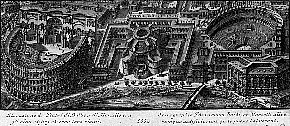
Pagan - Christian - Triumphal Way
3123h
3123i
3123j
3123k
1999.11.21
|